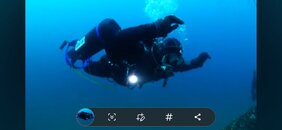So this situation hits on a bunch of issues. First is training. I was taught durring my cave dpv course to always lock the scooter down and verify the lock out when ever not riding, always means always even if this will just take a second, lock it down.
I'm not too familiar with that model of scooter but I would guess that the lock out mechanism has a detent that the lock screw will engage if fully screwed in. I doubt it only relies on friction to prevent operation of the trigger. But I could be wrong.
Open water dpv training really lacks core skills and procedures. I would like to see the mainstream diving organizations adopt some more disciplined techniques
In tech diving we are tought to use redundant everything. Yet we see divers just letting go of a dpv to preform a task or do deco. This bad habit let's the scooter float around and possibly get tangled or other crazy stuff. It's also difficult to retrieve when it's time to ride again.
Counting on the single point of attachment may also lead to loss of the dpv durring deco.
Letting the scooter float by the main leash is also like a parashoot if dealing with any current.
Adding an on off switch adds another hull penetraton and potential leak. So you need to decide if that additional function is worth the additional complexity.
We use the Anuk stow and tow system.
It's has a solid anchor point attached to the bottom of the hull when in the parked position.
We simply clip the leash off to our chest D ring when not riding and its secured out of the way but also ready to ride quickly if nessasary.
The scooter will naturally weather vain if we point ourselves into the flow.
Building the good habits of locking down and clipping off takse some time but its always faster to follow a good habit than to deal with the consequences of a bad habit .
Glad everyone is ok.







